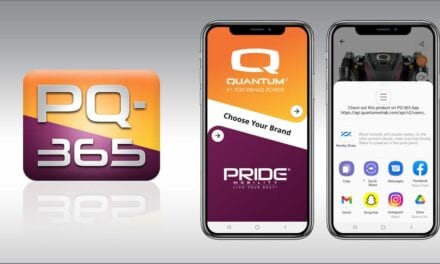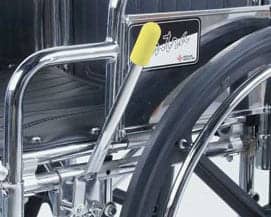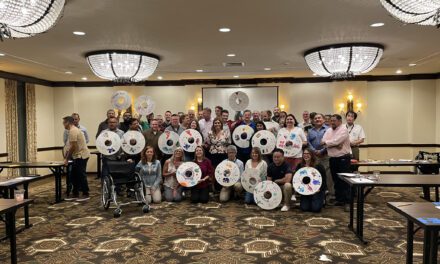PHOTO CAPTION: Wheelchairs and components, like people, come in many shapes and sizes. It is imperative that decisions are made on an individualized basis and in a team format with the user at the center.
The goal of a wheelchair is to allow the user a more independent lifestyle and minimize risk of injury or adverse outcomes. It is difficult to do this when a wheelchair is not properly sized to or configured for the specific user. When it comes to designing a wheelchair, there are many components from which to choose. It is imperative that the selections are based on individual needs and preferences.
Manual Wheelchairs
While there are many manual wheelchairs on the market, it is recommended that a long-term manual wheelchair (MWC) user utilize an ultra-lightweight wheelchair as it is fully customizable to match the user’s needs. Studies have shown wheelchair users push 2,000-3,000 times a day, showing the risk for repetitive upper extremity injury: the arm was not designed for such repetitive movement. If the wheelchair is light and set to allow good body mechanics, this can decrease the overall risk of injury. Below are only a few key points to remember when assessing design and fit in a MWC with a team of specialists.
Frames and Material
The frame of a wheelchair is like the foundation of a house: Without a strong material or design, the rest of the house doesn’t matter. A rigid frame is composed of metal bent or welded together to allow a one-piece design. This makes the frame lighter, more durable, and offers more efficient propulsion with less flex within the parts. Leg rests are integrated within the design, and different angles can accommodate the user’s need, footprint and turning radius. The folding frame is a two-piece design connected by cross bars and removable or swing-away leg rests. This type of leg rest can be preferred during sit-to-stand transitions or stand-pivot transfers. The folding frame does collapse sideways, whereas with the rigid frame the wheels pop off and the backrest folds down to allow storage. Choosing a frame style is user preference and may depend on vehicle transportation or home set-up.
A strong and durable material is important to maximize the lifespan of a wheelchair. Aluminum is the most popular, especially with payors, as it is the cheapest material. Aluminum has recently upgraded to the 7000-series aluminum, which is stronger than the previous series. Rising in popularity, though, are titanium and carbon fiber as they are lighter materials and have vibration-dampening qualities, which make the ride more comfortable and decreases the risk of injury from whole-body vibration. Titanium and carbon fiber are also known for their anti-corrosion properties. Carbon fiber is unique in that it is the lightest material but is customized when building and molding to increase its strength and durability. While carbon fiber and titanium are more expensive, the high strength and low weight may outweigh the cost.
Backrest Height
The backrest height is crucial for safe and efficient propulsion. Backrests were designed to provide support to the trunk, but are important to be placed at the lowest point of the trunk needing the support. If back support is too high it limits scapular movement, causing poor body mechanics to reach the wheel and propel. The backrest should be placed at the very least 20 mm below the lowest point on the shoulder blade. If support is significantly too low, it may result in instability or cause the user to slide into a posterior pelvic tilt, possibly creating further postural deformities. An ultra-lightweight wheelchair does allow for minor modifications in height upon delivery with the assistance of a professional.
Power Wheelchairs
Power Wheelchair Drive Configuration
Presently, power wheelchair bases are segregated into three drive types: mid-wheel (MWD), front wheel (FWD), and rear wheel (RWD). Which drive type is best depends on primary environments of use. The MWD chair has the tightest turning radius, able to turn 360 degrees in place. This makes it great for indoor driving, especially in smaller homes, offices or classrooms. With the drive wheel in the middle, the chair must have four casters – two in front and two in back – to maintain stability. The front casters can be inhibitory, especially with outdoor driving.
The FWD chair tends to function best outdoors. The design allows the chair to pull over obstacles or soft terrain. Though it can function indoors, the configuration results in a bigger turning radius and there is a lot of chair behind the user.
The RWD chair works very well in the urban environment, as it is very stable over a variety of surfaces and at faster speeds. This chair has the largest turning radius so, to combat this, one manufacturer has developed a hybrid system, moving the drive wheels slightly anterior on the base. The idea here is to reduce the overall size of the turning radius like MWD, while maintaining better outdoor performance. This chair does require the addition of two small casters at the rear of the base, which is not typical for RWD, to maintain stability.
Power Seat Functions
The most well-known power seat functions continue to be power tilt-in-space, recline, and elevating/articulating leg rests. The medical necessity of each of these functions are well-documented and well-researched. Evidence for the necessity of their use synchronously is mounting, especially as it relates to pressure distribution and management, shear reduction and edema control. The combined use of tilt-in-space and recline results in greater pressure reduction than either feature alone. Linking tilt-in-space, recline, and leg elevation ensures that the feet and ankles are above the heart. Using recline with leg elevation reduces shear forces on the buttocks, by decreasing the stretch to the commonly tense hamstrings. It is best practice to ensure that the complex power chair user receives all three of these functions.
Traditional tilt-in-space is in the posterior direction, meant to unweight the buttocks. More recently, anterior tilt has appeared on the scene. This is meant to increase functional reach, improving access to sinks, closets, cabinets, etc. Some seating systems also allow for lateral tilting, which is an alternate way to perform pressure reliefs and can be used to accommodate postural deviations, like scoliosis.
A function that is gaining popularity is power seat height adjustability (PASH). This allows the user to change seat heights as necessary for activities such as transfers, reaching items overhead or improving visibility and ability to speak with others at eye level. Traditionally, funding for this function has been challenging. However, with improvements in the technology itself, use has increased and so has understanding of its importance in daily function. One recent study of 24 individuals with PASH shows an average use of four times per day for transfers, reaching, improved visibility or mobility. Also, a majority of elevation events lasted for greater than 5 minutes, indicating elevation was used functionally in their environment. Based on such evidence, stakeholders are actively pushing for funding improvements.
Power Drive Controls
The joystick is the traditional and most common drive control. However, technology advances have facilitated many forms of alternative controls. Essentially, if users have consistent and safe control over a movement – they can drive.
With the release of an eye gaze control in 2019, this now includes eye movements. A tablet is mounted to the chair, anterior to the user. The tablet camera tracks the user’s eye movements, allowing them to choose and hold their gaze on a directional arrow on the screen. The chair then moves in that direction. The tablet’s second camera displays the environment in front of them on the screen, so that the user can see where they are going.
Seating, Cushions, Backrests
It is important to choose the correct cushion and backrest to provide appropriate support to maintain an independent lifestyle, but also allow the user to present themselves, not the chair. Outside parts on the chair should be kept to a minimum, and use of the cushion or backrest to provide support will help with this. Keeping cushions and backrests as small as possible looks better, and decreases the amount of unnecessary weight during propulsion and/or ease the transfer.
A cushion is designed to not only improve the user’s comfort, but also to assist with postural correction or accommodation. The pelvis is the base of support and should be positioned in a neutral position to maximize stability. If unable to reach neutral, cushions can help with accommodating the position to decrease risk of further postural deformity and allow full independence by the user in a seated position. Cushions can consist of foam, air, honeycomb, gel/fluid inserts, a hybrid/mix, or alternating cushion technologies. Cushions also vary in their clinical application: general, skin protection, positioning, or a combination. Wedges can be added to assist with correcting or complimenting postural deformities in most cushions, if the cushion itself does not provide enough support.
Each medium has different qualities such as pressure-relieving, temperature-regulating, positioning, or a combination, and choosing the right one is patient-dependent. The lighter the cushion, the easier it will be to transfer into the car and add less weight to the overall chair. However, a lighter cushion may be less supportive to assist with postural correction. It is important to have a cushion fit to the user for functional needs to ensure the appropriate stability while decreasing pressure injury risk.
Backrests facilitate proper postural alignment and support for the trunk, stability, efficient propulsion, and of course, comfort. Backrests are typically sling, adjustable tension, or rigid. A sling backrest is the typical presentation on a non-customized wheelchair and provides the least amount of support. Due to the flexibility and stretch of this upholstered material, over time it will provide very little support, causing a rounded posture. Propelling a wheelchair with this rounded posture will contribute to shoulder pain and repetitive upper-extremity strain. Adjustable tension backs are an option. However, they too have a tendency to loosen and stretch with pressure and time. A rigid back is recommended to provide adequate support to the torso and spinal column in the seated position. It has a solid posterior shell with a cushion serving as an interface. Depending on the user’s need, rigid backs do have the ability to have a small amount of contour.
If an off-the-shelf cushion and backrest are not providing enough support to maintain a neutral position, the deformity is too significant, or a continuous pressure wound is forming, a custom mold may be required. Custom-contoured seating uses an impression taken of the user to match the exact contours of their shape. This has been found to reduce the pressure experienced in weight-bearing areas by redistributing pressure more evenly over the seat. It can also provide more corrective postural support compared to off-the-shelf. RM
Erin Michael, PT, DPT, ATP/SMS, is Manager of Patient Advocacy and Special Programs at Kennedy Krieger Institute’s International Center for Spinal Cord Injury (ICSCI) in Baltimore. She specializes in treating paralyzing neurological conditions, including multiple sclerosis, transverse myelitis, cerebral palsy, and traumatic and non-traumatic spinal cord injury. Additionally, Michael is the coordinator of the ICSCI Seating and Mobility Clinic and has specialized in seating and mobility for nearly 12 years. Michael has a special interest in advocacy and is a member of the Clinician Task Force Executive Board.
Karli Stager, PT, DPT, ATP, is a physical therapist at the International Center for Spinal Cord Injury at Kennedy Krieger Institute in Baltimore. She is a certified assistive technology professional (ATP) assisting in seating clinic weekly at Kennedy Krieger Institute. For more information, contact [email protected].
This article was originally published in the 2020 November/December Rehab Management print edition and online with the title, “Designer Decisions.”





